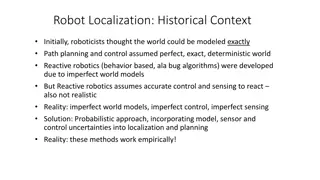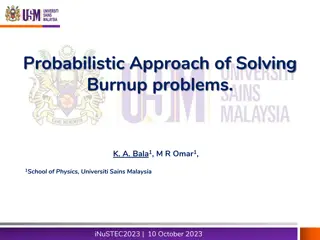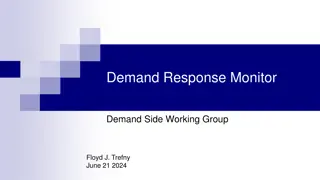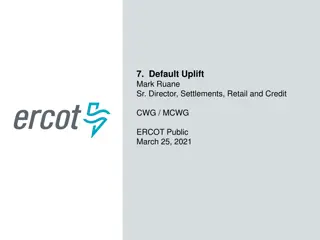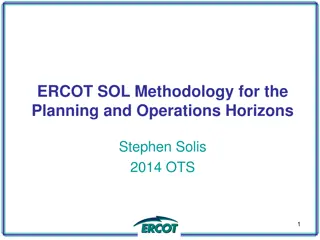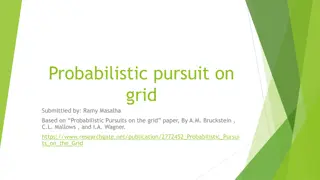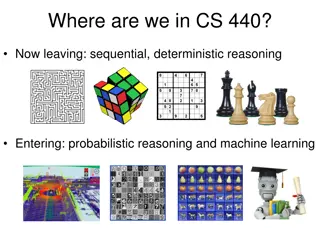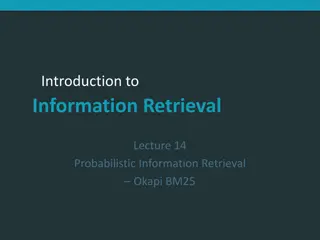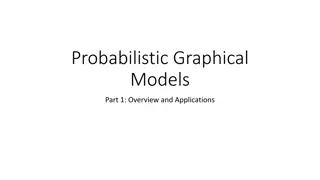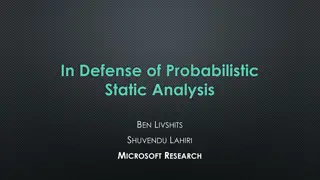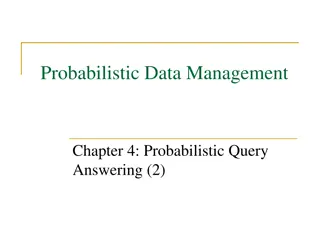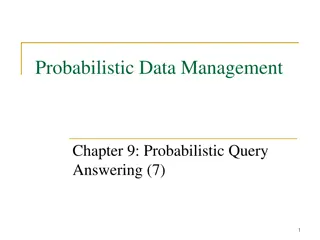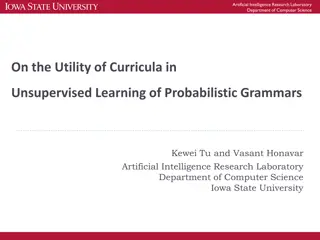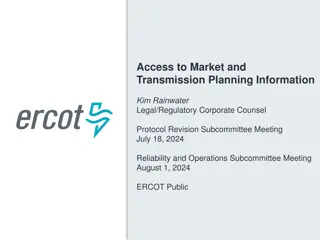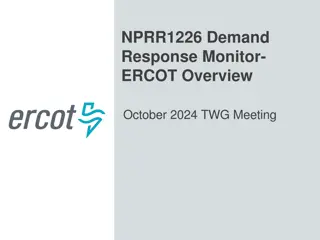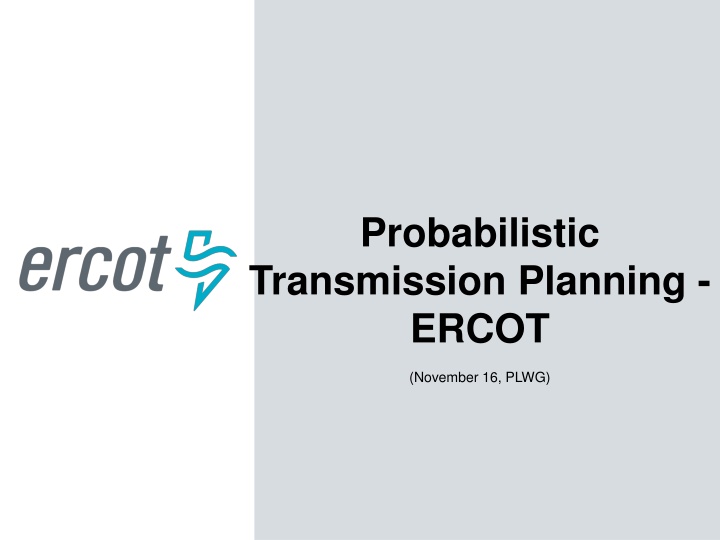
ERCOT Probabilistic Transmission Planning
This session will delve into ERCOT's approach to probabilistic transmission planning, covering key aspects and considerations for efficient grid management. Gain insights into the complexities of planning for reliable and resilient power transmission in ERCOT's network.
Uploaded on | 0 Views
Download Presentation

Please find below an Image/Link to download the presentation.
The content on the website is provided AS IS for your information and personal use only. It may not be sold, licensed, or shared on other websites without obtaining consent from the author. If you encounter any issues during the download, it is possible that the publisher has removed the file from their server.
You are allowed to download the files provided on this website for personal or commercial use, subject to the condition that they are used lawfully. All files are the property of their respective owners.
The content on the website is provided AS IS for your information and personal use only. It may not be sold, licensed, or shared on other websites without obtaining consent from the author.
E N D
Presentation Transcript
Probabilistic Transmission Planning - ERCOT (November 16, PLWG)
Contents Introduction Deterministic Vs Probabilistic Applications Efforts and Issues Next Steps & Summary Appendices 2 PUBLIC
Introduction Motivation 1) Increasing uncertainties (intermittent generation, distribution, weather pattern) are expected in ERCOT system NERC reliability standard requires to test a large number of contingencies and identify contingencies with severe impact 2) ERCOT and others within the industry are currently researching probabilistic transmission planning methods and tools. It is believed that deterministic planning processes can be enhanced by supplementing with a probabilistic planning approach The probabilistic planning concept is not new but not popular mainly because of the deterministic nature of planning standards, lack of tools, and lack of data 3 PUBLIC
Deterministic vs Probabilistic Transmission Planning Deterministic Approach Probabilistic Approach A large number of cases covering a wide spectrum of operating conditions by considering uncertainties of weather, intermittent generation, load forecast, economic, distribution side. Probability is assigned to each case Severalcases for certain operating conditions (e.g. summer peak and off peak) based on engineering judgement Reliability Analysis is done assuming each contingency is certain System issues (thermal loading, voltage, etc.) Reliability Analysis is done for each contingency that has outage statistics (frequency and duration). System issues (thermal, voltage, etc.) as well as Impact (e.g. load curtailment) Drawbacks of Deterministic Approach 1) does not cover various system conditions nor consider many uncertainties in a system 2) ignores likelihood of system conditions and the probability of events Risk Assessment (Risk = Impact x probability of events and scenario) (e.g. Expected Unserved Energy) 4 PUBLIC
Example: Magnitude of Risk Associated with Critical Event 5 PUBLIC
Applications Development of a number of credible study cases with many uncertainties considered Identification of critical planning or extreme events using likelihood, system impact or magnitude of risk associated with each event Evaluation of project alternatives in terms of benefit (e.g. test deeper contingencies such as substation outage: compute expected unserved energy (EUE) or incremental reliability index (IRI) to compare reliability benefit of each option Identification of weak areas based on the number of interruption of load at each bus, number of occurrence of thermal or voltage issues on line or bus Measure the health of real-time system (e.g. by computing EUE periodically) 6 PUBLIC
ERCOTs Efforts Mid 2014~1st qtr. 2015 ERCOT started to participate in the EPRI Risk-based Transmission Planning Program Goal: Develop basic concept, risk-based analysis method, metrics, data requirement guideline, new tools and improving existing tool for probabilistic planning Value: 1) Increase system reliability by considering deeper contingencies, 2) Incorporate some of the uncertainties, 3) Help us make a better decision on transmission investment Deliverables: 1) Technical document of the RBTP, 2) Prototype of tools (e.g. TransCARE, Outage statistic creation, Risk-based Scenario Builder) 1st qtr. 2015~1st qtr. 2016 EPRI performed a case study using the data ERCOT provided: 11 years of weather, historical wind and load data, and economic load forecast error to create a number of system conditions Transmission network models, contingency definitions Outage statistics from NERC TADS and GADS EPRI s ERCOT Case Study Deliverables: 1) Technical document of the case study, 2) Improved version of the tools (TransCARE, Risk-based Scenario Builder), 3) Cases and input data used for ERCOT Case study 1st qtr. 2016~present Using the cases and input data, ERCOT performed the analysis using the tools Identified many issues in tools and areas to improve, documented the problems and created user-guide Delivered the issues to EPRI so the tools can be fixed and improved For the proof of concept, ERCOT tested three transmission options using cases representing various system condition and extreme events such as substation outages and common right or way. The result has been delivered ERCOT s Review on EPRI s Case Study and Tools 7 PUBLIC
Framework of Probabilistic Risk Assessment Case Development Reliability Analysis Risk Assessment Tool: EPRI s TransCARE or PSS/E, Outage Statistics Creation Tool Tool: EPRI TransCARE or PSS/E Tool: EPRI s Risk-based Scenario Builder Input: cases, contingencies, user- defined contingencies, outage statistics of each element (e.g. NERC TADS or GADS data) Input: system impact (MW curtailment) associated with each contingency, probability of each critical contingency Input: historical data (11 year weather, renewable, load), 5 different load forecast errors, network model (RTP case), outage statistics (optional) Output: criteria violations, system impact (e.g. load curtailment), outage statistics of each event Output: risk metrics (e.g. EUE or IRI) Output: cases in PTI format, probability of each case, deeper contingencies (optional) Key issues to be resolved: Sensitive to slight change in operating condition resulting in Inconsistent result of system impact, numerous non-converged contingencies and tools not capable of calculating load curtailment for voltage collapse Key issues to be resolved: Data is the key to this probabilistic analysis. Outage statistics are needed for various contingency types (P1~P7) and extreme event Key issues to be resolved: How many cases need to be drawn to minimize the chances of missing critical operating conditions? Are those cases valid? 8 PUBLIC
TransCARE (Transmission Contingency And Reliability Evaluation) TransCARE, an improved version of an older EPRI program known as Transmission Reliability Evaluation for Large-Scale System (TRELSS), is designed for probabilistic reliability analysis Input data including outage statistics Power Flow Cases Probabilistic Reliability Assessment (TransCARE) Reliability Indices 9 PUBLIC
TransCARE (cont.) Input files to TransCARE: Power flow case: *.sav in PSSE version 32, or GE PSLF. Up to 10 cases Contingency: up to N-9 can be handled. Up to 1 million contingencies Outage Statistics: outage frequency and duration of each element Other optional files: Common mode outage data, breaker location data, generation dispatch data and load data Reliability Analysis and Remedial Actions: Available solution methods: DC and AC Full NR Reliability analysis: Circuit loading, high/low bus voltage, voltage deviation, etc. Remedial actions: Load curtailment, generation/shunt/transformer adjustments Protection Control Group (PCG) Analysis: simultaneously trip elements when a fault occurs anywhere within their primary protection zone. Reliability indices calculated: Frequency, Duration, and Severity of system problems (by bus, circuit, and for study area) Frequency, Duration and Severity of load curtailment as well as unserved energy (by bus and for study area as well as by contingency) 10 PUBLIC
Key Issues To Be Resolved Tools are research-grade. Significant improvement needed for tools Tools should be capable of computing system impact (e.g. MW load curtailment) to eliminate non-convergence (e.g. voltage collapse) in terms of MW load curtailment Results (e.g. MW load curtailment) need to be verified. TransCARE is very sensitive even for a slight change in a system Cases developed from RBSB tool needs to be verified. The number of cases to draw and study should be researched and determined Even if cases and tools are perfect, it may take longer time depending on the scope of study (e.g. a number of study cases, number of contingency combinations) 11 PUBLIC
Key Issues To Be Resolved (cont.) Availability of outage statistics Probabilistic data requires outage data of transmission elements and generators Nation-wide generic data: NERC GADS (generator outage data for decades), TADS (transmission with 200 kV above since 2008), Canadian Electricity Association (CEA, greater than 60 kV since 1980) Best practice is using ERCOT region-specific data (by weather zone, by event type (P1~P7, EE), by voltage level). These are currently not available Criteria is not available (e.g. threshold associated with system impact, probability of event, magnitude of risk) that triggers action 12 PUBLIC
Next Steps Tentative Schedule Present ~ 2018 Description 1. Continue to engage in EPRI s R&D project 2. Collect historical outage data for ERCOT system (e.g. voltage level, automatic vs non-automatic, cause, fault type, time/load level, weather zones), and investigate statistics such as P4, P5, P7, EE2 3. Analyze outage data collected and review against other statistics (e.g. NERC TADS, GADS or EPRI data) 4. Attempt to address the challenges identified and continue to work with EPRI to address issues with tools and more (e.g. cases, tools, statistics, criteria, metrics) 5. Test potential applications (ranking contingencies, risk metrics) 1. Continue to work with others in industry on the success of this concept 2. Continue to work on gathering historical outage data 3. Engage in EPRI program if exists 4. Consider risk metric(s) in decision-making (e.g. Evaluation of multiple options in ERCOT independent review) Beyond 2018 13 PUBLIC
Summary Probabilistic transmission planning approach is great idea and can be supplemental to the traditional deterministic planning process A number of issues with tools, data and criteria need to be addressed ERCOT will continue to work with others in industry and research institutes To investigate probabilistic transmission planning approach To address challenges and ultimately to apply this approach to the current planning process 14 PUBLIC
Appendix: Example - Probability of occurrence for load and wind output based on historical data 15 PUBLIC
Appendix: Expected Unserved Energy or Incremental Reliability Index Expected Unserved Energy (EUE) ??? = ?????????? ????????? ??????????? ? ? Note: where i is an event and K is a set of contingency i The unit of EUE is ?? ?? ???? The unit of frequency is ?????? ???? The unit of duration is ?????????????? ?????? The unit of Unserved MW is MW * Note: EUE can be calculated for all cases tested and probability of each case need to be multiplied) Incremental Reliability Index (IRI) = reliability improvement per million dollar EUE before project - EUE after project Capital cost of project ($M) 16 PUBLIC
Appendix: Issues and Suggested Improvements EPRI Scenario Creation Tool (RBPSB) TransCARE RBPSB >> TransCARE 1. Questionable remedial actions 1.Several adjustments (defining new zones, change of swing bus, etc.) on re-dispatched power flow scenarios need to be made to be able to run in TransCARE (Manual Process) 1. Generators dispatch to include reserve not losses 2. Post contingency power flow solving issues(diverge, large mismatch) 2.Does not randomly sample scenarios 2. TransCARE s capability of handling up to 10 scenarios once might not be sufficient to implement the idea of stratified sampling. API tools are needed such that TransCARE can be run as an engine in scripts 3.Does not have enough information to map output back to input data 3. Does not recognize unrealistic contingencies (a filter function is needed) 4. Does not keep a track of skipped must-run contingencies 4.Does not solve and validate re-dispatched power flow scenarios 5. Enumeration does not work properly 5.Output does not include probability of scenarios and strata 6. Report data format needs to be improved 6. Unclear documentation on sampling scenarios based on distribution within strata 7. Better documentation on EUE calculation methodology is needed 17 PUBLIC
Supervisor, Transmission Planning Engineer, Resource Adequacy ERCOT Probabilistic Planning Team Supervisor, Engineer Development Program Principal, Grid Integration Engineer, Transmission Planning Lead Engineer, Resource Adequacy

